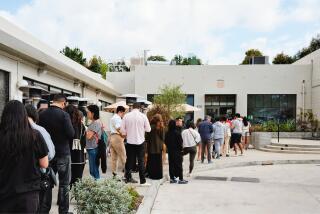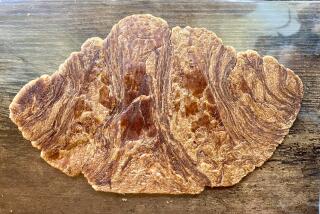Full of Holes? Some Doubt Krispy Kreme’s Growth Prospects
- Share via
The American doughnut was born in 1847, so the lore goes, when a Maine seaman urged his mother to shove a fork through the center of her “fried cakes.” That solved the problem of the cakes’ soggy middle and created the doughnut’s trademark hole.
Today, perhaps the most celebrated of the sweet treats are those fried up by Krispy Kreme Doughnuts Inc., whose hot “original glazed” doughnuts have earned a cult-like following. With virtually no advertising, but an uncanny knack for creating free publicity through the media, the company keeps racking up double-digit gains in sales and profit.
Skeptics keep trying to poke holes in the Krispy Kreme mystique -- questioning whether the company can maintain its remarkable growth. Some analysts believe its growth rates already are beginning to ease. They also contend that the company’s stock remains too rich for most tastes.
Their argument appears to hold some water. Krispy Kreme’s stock, after skyrocketing at first, trades for less than it did two years ago despite the company’s consistent growth record.
But the company is unmoved by the pessimists and has no intention of scaling back its aggressive expansion plans, which include Southern California.
“We may be in the first or second inning of our market penetration opportunities around the world, including the United States,” said Scott Livengood, Krispy Kreme’s chairman and chief executive.
With 288 stores in 38 states and Canada, Krispy Kreme is starting to expand into smaller U.S. cities and other foreign markets. It sees potential for hundreds of additional stores worldwide.
In Southern California, where the company started with its La Habra store in 1999, it now has 22 locations employing 1,300 people. And more are on the horizon.
“We’d expect to build as many as 50 stores over the next five years” in Southern California, said Richard Reinis, chief executive of Great Circle Family Foods, a Los Angeles company formed to be Krispy Kreme’s Southern California franchisee.
Among the target locations: Santa Monica, Newport Beach, Laguna Beach and La Jolla. The company also is thinking of building a West Coast distribution plant, possibly in California, within three years.
Krispy Kreme is a story some have found too good to be true ever since the company went public three years ago. Yet the stalwart reputation of the doughnuts -- abetted by media that pump up every new store opening as a local sensation -- helps maintain the company’s prosperity.
As Starbucks Corp. did with coffee shops, Krispy Kreme has transformed a commodity product into a branded specialty with devoted fans.
And despite the hand-wringing about its outlook, the company’s total stock market value is $2 billion. That means each of its stores, which range in size from 800 to 5,000 square feet, is worth nearly $7 million.
Krispy Kreme was started 66 years ago in Winston-Salem, N.C., where it still has its headquarters. Its doughnuts were mainly a Southern treat until the 1990s, when the company began expanding north and west.
The chain’s reputation preceded it everywhere. People would camp out for hours, even days, to be first in line to taste a Krispy Kreme at a new location and watch the doughnuts being made.
The media loved “the hubbub,” as one Krispy Kreme executive calls it, and they helped the company burst onto the national stage. It was advertising that money couldn’t buy, not that Krispy Kreme would anyway. The company doesn’t spend a dime on advertising.
Instead, everyone at Krispy Kreme from Livengood on down deftly encourages its loyalists to keep the buzz alive.
Sharing the ‘Experience’
Making a 50-cent Krispy Kreme doughnut is “almost hypnotic,” Livengood (rhymes with “drive-in-good”) rhapsodized in his deep, steady voice. There’s “the animation and the giving birth,” he said, “the theater aspect of it” and the way it forms “a relationship that is emotional.”
What some might think of as a mere tasty mixture of dough and sugar, Livengood considers “almost as a member of the family.” To him and his customers, a Krispy Kreme isn’t just something to chow down with coffee, it’s an “experience.”
Investors had quite the experience in mid-2000, when the company first sold its stock to the public. Wall Street was left slack-jawed as the shares soared like those of the dot-com companies of the time -- before the crash. Its stock rose more than sevenfold after going public at $5.25 a share (adjusting for splits since then).
Livengood & Co. were under pressure to keep delivering big gains in sales and profit, and they didn’t disappoint. Quarter after quarter, Krispy Kreme has posted double-digit growth.
It’s not just expansion that’s pushing the growth, either. The chain’s same-store sales -- those of stores open at least a year, and a key measure of customer loyalty -- also have climbed by double digits for 13 straight quarters.
The company owns 104 of its stores; the rest are owned by franchisees, some of which have Krispy Kreme as an equity partner. The company sells its doughnut mix, doughnut-making equipment, coffee and other supplies to the franchisees.
Its systemwide sales, including company-owned and franchise stores, are expected to top $1 billion for the first time this year. Sales for Krispy Kreme alone totaled $492 million in its fiscal year ended Feb. 2, up 25% from the previous year.
In its fiscal first quarter ended May 4, Krispy Kreme’s profit soared 48% from a year earlier, and the company nudged up its earnings estimate for the full fiscal year, to 90 cents a share.
Krispy Kreme’s stock has gained 10% since the results were announced May 28. The stock closed Friday at $35.05 a share, down $1.40 on the New York Stock Exchange.
That means investors are paying about 39 times this year’s expected earnings per share to own Krispy Kreme -- much more than they’re paying for General Electric Co. or Cisco Systems Inc.
At one time, Krispy Kreme’s price-to-earnings multiple topped 50. But even today’s price is too high for some analysts, no matter the emotional attachment customers have to the doughnuts.
Rising Analyst Concern
Consider: In the first quarter, Krispy Kreme’s systemwide sales jumped a stout 24% from a year earlier. But analyst John Ivankoe of J.P. Morgan Securities and others on Wall Street had expected at least a 28% gain, and it was the third straight quarter that the company’s growth, though robust, fell short of forecasts.
“We are nervous given the continued shortfall” and a lofty P/E ratio, which “limit our enthusiasm for the stock in the near term,” Ivankoe said in a report after the earnings came out. He rates the shares “neutral.”
So Krispy Kreme remains a favorite of “short sellers,” traders who bet on stock prices falling. About 15% of its shares outstanding are sold short.
In the first quarter, it was “demonstrably clear that sales were below plan,” and “there’s been a steady deceleration in revenues,” asserted David Rocker, managing partner of Rocker Partners, a New York hedge fund that is shorting the stock.
Yet others, such as analyst David Geraty of RBC Capital Markets, are still recommending the shares. Krispy Kreme has “a 60-year-old brand, a loyal customer base and is in the infancy of growth,” and that high P/E is “well-deserved,” he said in a report last month.
Indeed, Krispy Kreme remains a pipsqueak compared with the nation’s largest doughnut chain, Dunkin’ Donuts, a subsidiary of British spirits maker Allied Domecq that has 5,400 locations in 32 countries.
Although some debate its worth, the company is resolute about expansion. It is mapping plans to open stores in Australia, New Zealand, Britain, Mexico and Japan.
In each locale, they’ll pose the same question that’s always been asked: Will this Southern-based doughnut sell here?
“I have a healthy anxiety about every time we’ve gone into a new region,” Livengood said. “It’s not a lack of confidence, just a healthy fear.”
Southern California was no exception. “We’d been warned” that Krispy Kreme might flop in the region, if for no other reason than 1,350 doughnut shops already battle it out in the market, said Reinis, the Krispy Kreme franchisee. “But we believed we had a better doughnut at a competitive price.”
Those rivals include Winchell’s Donut House, the West Coast’s largest doughnut chain with 200 stores, most of them in California. Winchell’s, a Santa Ana-based unit of Canada’s Shato Holdings Ltd., quickly upgraded its product line to meet the challenge. Mom-and-pop operators, many of them Cambodian immigrants, also braced for the Krispy Kreme onslaught.
Small in the Southland
For all its exposure, Krispy Kreme accounts for less than 2% of Southern California doughnut shops. Yes, fans will drive out of their way to reach the nearest store, yet many consumers choose convenience and buy doughnuts from nearby vendors.
In any case, “I don’t think we’re in competition with the mom-and-pop shops because they’re serving other things than doughnuts,” such as pastries and various drinks, Reinis said. Krispy Kreme, he said, focuses on selling doughnuts by the dozen, for about $5.99.
The main customers are the “office heroes, soccer moms and church socials” buying Krispy Kremes by the box, he said.
Although the chain doesn’t advertise, it does promote like heck. It routinely gives away doughnuts in marketing drives, peddles them in supermarkets such as Albertson’s to create brand awareness and operates Krispy Kreme stands at Dodger Stadium.
Now the company is aiming to develop smaller stores in cities such as San Francisco and New York, where real estate is at a premium.
That will keep Livengood’s healthy fear alive. But, “to my absolute delight, it seems like every time we’ve moved into a new region, things have gone better than ever,” he said.
Will that hold true in say, Tokyo or London?
“My instincts are it will continue,” he said. “We know the buzz has already begun.”
More to Read
Inside the business of entertainment
The Wide Shot brings you news, analysis and insights on everything from streaming wars to production — and what it all means for the future.
You may occasionally receive promotional content from the Los Angeles Times.











